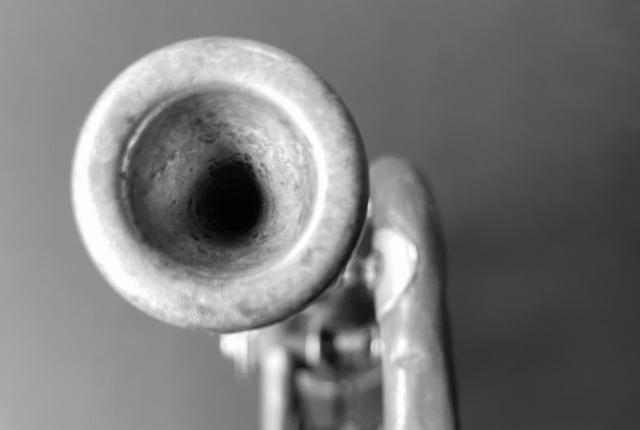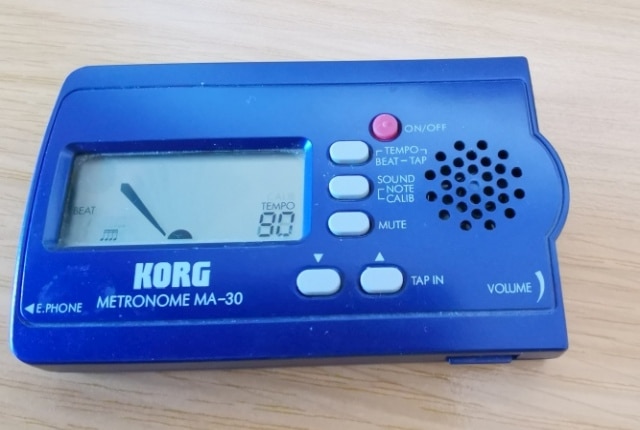Have you ever wondered how to practice trumpet without a trumpet, maybe because you’re traveling without your instrument, it’s being repaired, or you simply want to use your commute better? The good news is, there are several ways you can improve your capabilities as a trumpeter even without a trumpet to play on. Let’s look at 7 methods that work.
How To Practice Trumpet Without A Trumpet
What is it that you can specifically do to practice the trumpet when you don’t have a trumpet with you?
These are 7 methods we’ve come up with to help you with that.
1. Practice With A PETE (Embouchure Trainer)
The PETE (or P.E.T.E., Personal Embouchure Training Device) is an exercise device that helps you build up the muscles in your mouth. It’s like weight training for your chops.
These are great to use on a commute in the car or when you’re alone in a hotel room, but would likely get you strange stares if used in public.
As a muscle builder, the P.E.T.E. is very effective, and even if you do have your instrument around, it is good exercise you can do on top of your regular practice to really build up your chops.
2. Try Free Buzzing With Only Your Mouthpiece
Free buzzing means buzzing your lips with the mouthpiece while trying to hold the embouchure you would while actually playing. Try to keep the pressure on the mouthpiece down and concentrate on a steady air stream.
Some swear by free buzzing and recommend practicing scales this way. You can also use a tuner to make sure you get the intonation right. Others are more dismissive of free buzzing as a training tool.
Whether or not it works for you also depends on the effort you put into it. Try to be mindful when you do it and really think about what you’re doing.
If you want to learn more about free-buzzing or get some inspiration, pick up James Thompson’s The Buzzing Book*, which is full of great exercises.

3. Practice Lip Exercises
Another way to practice even without a mouthpiece are isometric exercises. When you really target certain muscles, it’s surprising how quickly you can feel the burn and need to stop. Do these regularly and you’ll be able to build and stabilize your embouchure.
There’s an inexpensive book by David Boe* that teaches you everything you need to know. The book is only 40 pages or so, but it’s definitely worth it if you’re dedicated to actually doing the exercises. The author has also published a YouTube video to give readers an idea of what to expect.
These exercises are quiet and need no mouthpiece or other equipment, so they’re great for commuting, even on a train among other people.
4. Practice Your Fingering On Your Forearm
If you’re without a trumpet, you can also practice the fingering on your forearm or on a pencil. Again, what’s important is the mental side of things: Really imagine the music, really try to hear what you’re playing.
Playing the trumpet, or any instrument, is not only about having good chops, a good embouchure, a good coordination, and quick fingers. A lot – if not most – of the playing happens in your brain.
Listen to Hal Galper explaining how YOU are the instrument if you’re unsure if practicing the trumpet without an instrument can help:
5. Listen To The Pros
To step away from the “mechanical” things you can practice, let’s move further into the mental realm. Listening to good trumpet music can also help you improve if you pay close attention.
What is their sound like? Do you notice anything special? Listen to the articulations and phrasing to really develop a sense of the instrument. It might make you curious to try out with your own instrument later to compare yourself with the greats.
6. Read Relevant Books
Reading can also help you improve your skills if you’re reading relevant books. While study books may not be something you want to read through, there are many other books that can open your mind to new things, for example:
- Miles Davis’ autobiography*
- Dizzy Gillespie’s To Be Or Not … To Bop*
- I Walked With Giants: The Autobiography of Jimmy Heath*
- Atomic Habits* by James Clear
- Music Theory For Dummies*
And many more.
Looking for a teacher?
Want to get lessons at the comfort of your own home? Check out the course Learn to Play the Trumpet: Beginner to Pro Made the Easy Way* on Udemy! (See their full trumpet course line-up here*!)
7. Sing
In line with what Hal Galper said, singing can really help you put your head in the right frame of mind and learning the music “aurally” (by hearing). Singing helps you understand the music and learn it by heart, and it’s a great way to practice musical pieces you’re working on.
Singing is also an easy way to practice improvisation skills and training your ear, and it helps you understand what the music is supposed to sound like.
Final Thoughts
There are a lot of ways to practice the trumpet without a trumpet if you think out of the box a little bit. Of course, nothing really replaces spending practice time with your instrument, but many of the methods we’ve seen are great for building additional chops or skills.
If the reason why you want to play without your instrument is to keep the volume down, we have other methods to practice quietly for you as well, such as a Yamaha Silent Brass system or a decent practice mute.
Related Posts:
- 11 Famous Songs with Great Trumpet Parts
- 9 Useful Tips Against Stage Fright and Dry Mouth
- 9 Trumpet Books for Effective Self-Study
- Fascinating Trumpeter’s Trivia – Frequent Questions Answered
- The 5 Worst Things When it Comes to Playing a Trumpet (and How to Avoid Them!)
- Playing the trumpet left-handed (EVERYTHING you need to know)



